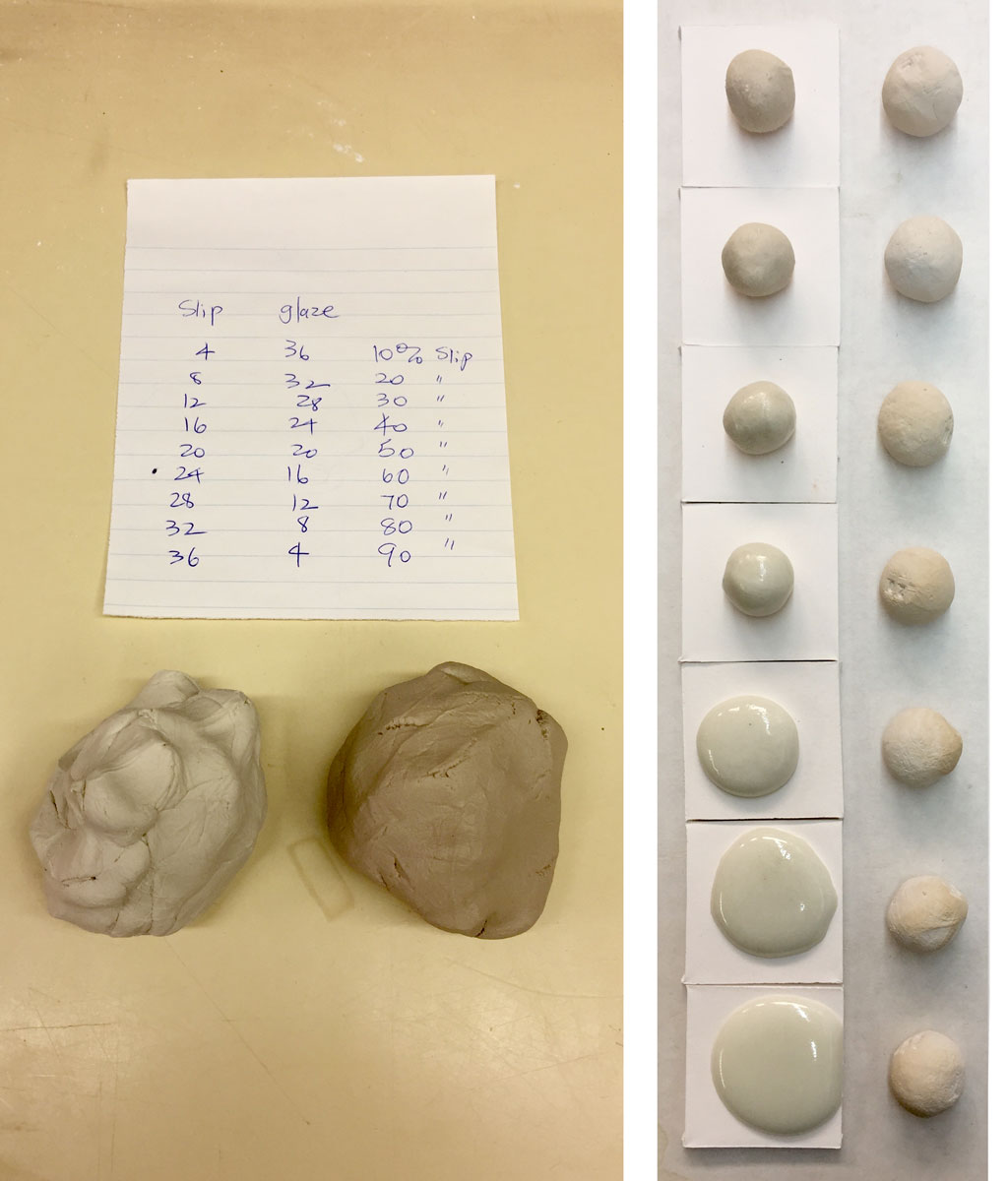| Monthly Tech-Tip | No tracking! No ads! |
Blending an engobe and a glaze to produce an underglaze
These fired samples demostrarte how you could develop your own Stroke & Coat glazes. I made these blends by dewatering an engobe (L3954B) and glaze (G2926B) and then hand-mixing line blending them. The left column is the fired blends (cone 6), the right one the unfired ones (showing the increase in soluble salts as the percentage of glaze increases). The right one shows the increase in melt fluidity. The top ones are 30:70 glaze:engobe and the bottom ones are 90:10 glaze:engobe. Notice the big change in melt fluidity between 60 and 70% glaze (third and fourth from bottom). And that the 70% one is quite glossy even though it has very low melt fluidity. Somewhere between 60 and 70 we could isolate a glaze-like product having underglaze stability. Stains could be incorporated and the proportion of glaze:underglaze adjusted according to its effect on melt fluidity. Doing this yourself enables targeting an exact melt fluidity for each color at the target temperature. The commercial product does not do that. You can also use more stain then they do to get more vibrant color for thinner applications.
Related Pictures
Here is my setup to make brushing glazes and underglazes by-the-jar

This picture has its own page with more detail, click here to see it.
Although I promote DIY dipping glazes, you can also make DIY brushing glazes. Let's make a low SG version of G2934BL. Weigh out a 340g batch of dipping glaze powder. Include 5g Veegum (to gel the slurry to enable more than normal water) and 5g CMC gum (to slow drying and impart brushing properties). Measure 440g of water initially (adjusting later if needed). Shake-mix all the powder in a plastic bag. Pour it into the water, which is blender mixing on low speed, and finish with 20 seconds on high speed. This just fills a 500ml jar. In subsequent batches, I adjust the Veegum for more or less gel, the CMC for slower or faster drying and the water amount for thicker or thinner painted layers. Later I also assess whether the CMC gum is being degraded by microbial attack - often evident if the slurry thins and loses its gel. Dipping glaze recipes can and do respond differently to the gums. Those having little clay content work well (e.g. reactive and crystalline glazes). If bentonite is present it is often best to leave it out. Recipes having high percentages of ball clay or kaolin might work best with less Veegum. Keeping good notes (with pictures) is essential to reach the objective here: Good brushing properties. We always use code-numbering (in our group account at Insight-live.com) and write those on the jars and test pieces. This is so worthwhile doing that I make quality custom labels for each jar!
Stroke & Coat colors

This picture has its own page with more detail, click here to see it.
This custom sample board was made by Solange Roy, it is great evidence of her meticulous and thorough approach to ceramics. This picture is taken at an angle to show the surface finish and character. These are Stroke & Coat ® underglazes, they are made by Mayco and widely used and praised. Although used as such by countless potters, they are not traditional underglazes (like Mayco Fundamentals or Amaco Velvets). They are heavily pigmented and have a highly controlled viscous melt fluidity. Applied by brush they give watercolour-like effects in thin applications and increasingly opaque coverage with each added layer. These products give evidence of meticulous lab work (like this board done by Solange), technicians would have had to do melt fluidity tests of each color and fine-tune the base recipe to get the desired degree of melt fluidity (compensating for the unique effect on melting of each stain type and percentage needed).
Videos
Links
| URLs |
https://www.maycocolors.com/color/fired/stroke-coat/
Stroke & Coat® are glazes, not underglazes. They are heavily pigmented and have a viscous melt. Applied by brush they give watercolour-like effects in thin applications and increasingly opaque coverage with each added layer. |
| Glossary |
Underglaze
An intensely pigmented highly opaque non-melting ceramic material mix meant to adhere best to leather hard pottery and fire-fit the body. Often transparently overglazed. Starter recipes. |
Got a Question?
Buy me a coffee and we can talk

https://backup.digitalfire.com, All Rights Reserved
Privacy Policy

